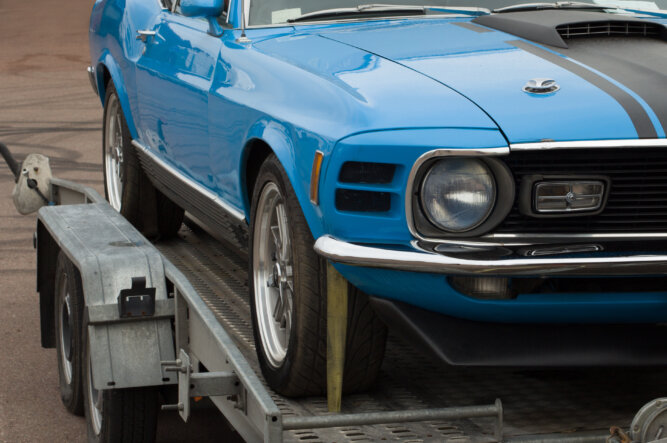8 Steps to Start a Hotshot Trucking Business

There's a better way to find loads.
Demo the Truckstop Load Board and see how easy it is to find the right loads fast.
Find your next load
Make more money starting now.
Looking to gain trucking experience in trucking or kickstart your own small business? Hotshot trucking might be just the opportunity you’re looking for. All you need is a medium-duty truck, some business know-how, and a passion for life on the road. Plus, the startup costs are much lower compared to most owner-operator trucking businesses, making it a great option for beginners.
This eight-step guide teaches you how to become a hotshot driver and get your business rolling.
What is hotshot trucking?
Hotshot trucking involves small, time-sensitive deliveries to a single destination. Large carriers prioritize high volume, while hotshot trucking companies focus on speed and flexibility.
Drivers are often independent contractors with their own vehicles. They haul less-than-truckload (LTL) loads like machinery, construction materials, or other freight. For example, a construction company may “hotshot” an urgent equipment delivery between job sites.
Hotshot drivers find freight on load boards or through brokers. It’s a great way to make extra cash as an independent owner-operator. Let’s break down the steps to start a hotshot trucking business
1. Get a commercial driver’s license
If you plan to haul loads under 10,000 pounds, you can get by with a standard Class D driver’s license. However, this limits your ability to transport heavier cargo. Getting a commercial driver’s license (CDL) opens you up to more jobs and lets you expand into larger trucks. CDLs range from Class A to Class C, depending on vehicle weight and load type. Be sure to check the requirements for getting a CDL in your state before getting started.
2. Obtain a medical examiner’s certificate (MEC)
Hotshot truck drivers may need a Department of Transportation (DOT) medical card. The Federal Motor Carrier Safety Administration (FMCSA) requires a medical card for truckers operating certain vehicle weights or carrying hazardous materials. A DOT medical examiner assesses commercial truck drivers’ physical, mental, and emotional fitness.
3. Establish your business
You need to set up and register your company before you can start earning income.
Here’s how:
Create a business plan: A business plan outlines your company’s objectives and strategies. This roadmap helps you run your business and finance hotshot trucking startup costs. You can find templates online for a detailed plan to secure funding.
Register your business: Start by choosing a name and deciding on a business structure. The structure you choose will impact your liability protection and tax benefits. For most hotshot businesses, a limited liability company (LLC) is a smart choice. An LLC helps protect your personal assets and avoids double taxation, which can happen with other business structures in some states. Once you’ve settled on a name and structure, it’s time to register your business with your state. Not sure where to start? The Small Business Administration (SBA) offers helpful guidance on the registration process.
Apply for an employer identification number (EIN): The IRS issues companies an EIN for tax reporting. This number lets you hire employees and start a business bank account. Opening a company account to separate your business and personal finances is a good idea. An EIN allows you to pay yourself and other employees wages and contribute more to your 401(k) than you can as an individual.
4. Choose the best insurance
Insurance protects your company and vehicle from liability and other claims. Consider the following:
- Primary liability insurance protects your assets if you damage property or cause injury.
- Cargo insurance protects the loads you carry from loss, damage, or theft.
- Physical damage insurance covers your truck and trailer for damage, theft, or accidents.
- Non-trucking liability (NTL) insurance covers your truck for personal use.
5. Get your operating authority
If you plan to haul loads across state lines, you need to apply for a USDOT and motor carrier (MC) authority number from the FMCSA. You can apply by completing online forms, paying registration fees of $300 per form, and submitting insurance proof.
Getting your own authority involves a lot of paperwork. You could also “lease” your vehicle to a carrier and operate under their authority. Most companies charge for this service, but it is an easier way to go. Either way, you will need a DOT number to operate your business.
6. Purchase or lease equipment
To start hauling loads, you’ll need a truck and trailer. Think about whether buying or leasing makes more sense for your situation—like how much cash you have upfront and whether owning the equipment matters to you. Don’t forget to budget for the extras, like tie-downs, dollies, or straps, to get the job done right.
Different kinds of trucks and trailers handle different types of loads. Most hotshot trucks are medium-sized but larger than pickup trucks. There are three medium-duty classes classified by gross vehicle weight rating (GVWR):
- Class 3: Vehicles in this class have a GVWR of 10,001 to 14,000 pounds, suiting lighter hotshot loads.
- Class 4: Theseheavier, noncommercialtrucks have a14,001 to 16,000 pounds GVWR.
- Class 5: Classified as a light commercial truck, class 5 vehicles have a GVWR of 16,001 to 19,500 pounds.
You can also use trailers to expand your load-carrying capacity:
- Bumper pull trailers: These cost-effective and easy-to-use trailers are popular with civilian drivers. They suit loads less than 10,000 pounds.
- Gooseneck trailers: Goosenecks can carry heavier loads. They have a tighter turn radius than bumper pull trailers.
- Tilt deck trailers: These trailers tilt at an angle for easier heavy cargo loading.
- Lowboy trailers: A low center of gravity makes lowboys ideal for the heaviest loads.
- Dovetail trailers: Since they sit low to the ground, dovetails suit hauling cars or other equipment with wheels.
7. Manage your finances
Figure out your rate per mile (RPM) by looking at the market, your expenses, and what competitors are charging. Keeping track of your money is key, so set up a solid system for managing your income and expenses. Hiring a bookkeeper can save you time and stress if you can afford it. If not, a good spreadsheet or accounting software works just fine. Be sure to keep an eye on costs like insurance, fuel, taxes, and maintenance to make sure you’re staying profitable.
8. Find hotshot loads
You’re ready to start taking on jobs! Load boards are the best way to find quality loads from reliable and qualified sources. With the Truckstop Load Board, you get unlimited searches, the ability to post your truck, and even instant booking to keep things moving fast. The quicker you find loads, the more money you can make. Plus, load boards help you connect with shippers and brokers, building relationships that can lead to more work down the road.
Become a trucking hotshot with Truckstop
Truckstop empowers hotshot trucking companies with innovative tools to boost efficiency and success. Our factoring service gets you paid within 24 hours of invoice verification. For load searches on the move, Truckstop Go™ brings you the power of our load board in the palm of your hand.
Discover how we can take your hotshot trucking business to new heights! Request a free load board demo.

Find out how our platform gives you the visibility you need to get more done.
Get helpful content delivered to your inbox.
Schedule a demo.
Find out how our platform gives you the visibility you need to get more done.





